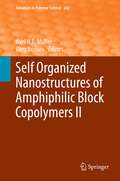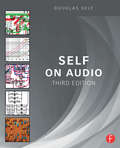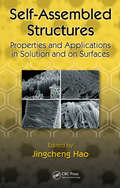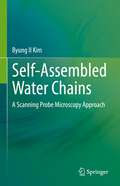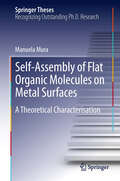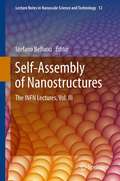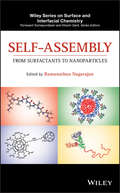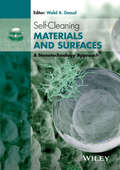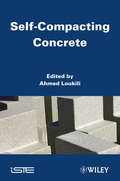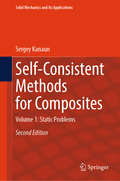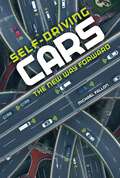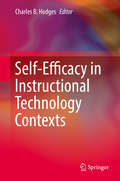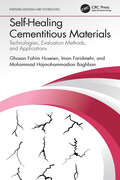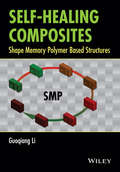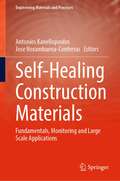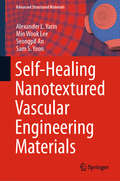- Table View
- List View
Self Organized Nanostructures of Amphiphilic Block Copolymers I
by Oleg Borisov Axel H. MüllerConformations and Solution Properties of Star-Branched Polyelectrolytes, by Oleg V. Borisov, Ekaterina B. Zhulina, Frans A. M. Leermakers, Matthias Ballauff and Axel H. E. Müller; Self-Assembled Structures of Amphiphilic Ionic Block Copolymers: Theory, Self-Consistent Field Modeling and Experiment, by Oleg V. Borisov, Ekaternia B. Zhulina, Frans A. M. Leermakers and Axel H. E. Müller; Interpolyelectrolyte Complexes Based on Polyionic Species of Branched Topology, by Dmitry V. Pergushov, Oleg V. Borisov, Alexander B. Zezin and Axel H. E. Müller; Co-assembly of Charged Copolymers as a Novel Pathway Towards Reversible Janus Micelles, by Ilja K. Voets, Frans A. Leermakers, Arie de Keizer, Marat Charlaganov and Martien A. Cohen Stuart; Fluorescence Spectroscopy as a Tool for Investigating the Self-Organized Polyelectrolyte Systems, by Karel Procházka, Zuzana Limpouchová, Filip Uhlík, Peter Košovan, Pavel Matejícek, Miroslav Štepánek, Mariusz Uchman, Jitka Kuldová, Radek Šachl, Jana Humpolícková, and M. Hof
Self on Audio: The Collected Audio Design Articles of Douglas Self
by Douglas SelfSelf on Audio: The collected audio design articles of Douglas Self, Third Edition is the most comprehensive collection of significant articles in the technical audio press. This third edition features 45 articles that first appeared in Elektor, Linear Audio, and Electronics World.Including expanded prefaces for each article, the author provides background information and circuit commentary. The articles cover both discrete and opamp preamplifier design, mixing console design, and power amplifier design. The preamplifier designs are illuminated by the very latest research on low noise and RIAA equalization. The famous series of 1993 articles on power amplifier distortion is included, with an extensive commentary reflecting the latest research on compensation and ultra-low distortion techniques. This book addresses the widened scope of technology that has become available to the audio designer over the last 35 years.New materials include: Prefaces that explain the historical background of the articles, why they were written, and the best use of the technology of the day Extensive details, including schematics, of designs that preceded or followed the design in each article, giving an enormous amount of extra information and a comprehensive overview of how author's design approaches have evolved New directions for the technology, describing new lines of thought such as curvilinear Class-A
Self-Assembled Structures: Properties and Applications in Solution and on Surfaces
by Jingcheng HaoSelf-assembly is a process in which a disordered system forms an organized structure without external direction. Examples include the formation of molecular crystals, lipid bilayers, and polymer brushes. This book reviews the fabrication and use of various self-assembled materials. In particular, the author pays special attention to self-assembled structures when in solution and in contact with surfaces, as such interactions can have a pronounced impact on their properties and applications. The text covers bulk solution and surfaces, assembled structures, colloid particles, polymer capsules, carbon nanotubes, as well as layer-by-layer assembly techniques.
Self-Assembled Water Chains: A Scanning Probe Microscopy Approach
by Byung Il KimDespite advances in the long-range electrostatic double-layer force, which depends strongly on ionic strength in water by using theoretical models such as DLVO (Derjaguin, Landau, Verwey, and Overbeek), the structure of confined water in air still remains widely unknown and has led to a variety of unexplained phenomena. This book bridges that gap by introducing a newly developed scanning probe miscroscopy (SPM) approach, which enables one to probe confined water at the molecular and atomic scale. Written by the developer of SPM, this book covers this new approach, as well as original approaches to addressing general interfacial water issues. It also introduces the cantilever-based optical interfacial force microscope (COIFM), which was invented by the author along with the methodology. The improved understanding will contribute to liquid-based nano- and bio-technologies such as lab-on-a-chip technologies, nanofluidic devices, dip-pen nanolithography, nano-oxidation, water-based granular interactions, liquid-based nanolubricants, hydration layers in biopolymers, manipulation of biomolecules, protein folding, stability of colloid suspensions, enzyme activity, swelling in clays, development of bioactive surfaces, water columns and ion channeling in membranes and scanning probe microscopy (SPM). It will also contribute to the improved performance of moving components in silicon-based micro-electro-mechanical system (MEMS) devices, where water plays a key role in interfacial interactions.
Self-Assembly of Flat Organic Molecules on Metal Surfaces
by Manuela MuraManuela Mura's thesis is devoted to ab initio studies of self-assembled organic molecules on a gold surface. This area of research is particularly vibrant because of the various applications such studies have in nanoscience and surface chemistry and physics. In this thesis Manuela Mura uses theory to suggest atomistic models for the observed assembled and she proposes an assembly mechanism. The methods and results developed as part of this work will be of wide interest to physicists and chemists working on the assemblies of organic molecules on crystal surfaces.
Self-Assembly of Nanostructures
by Stefano BellucciThis is the third volume in a series of books on selected topics in Nanoscale Science and Technology based on lectures given at the well-known Istituto Nazionale di Fisica Nucleare (INFN) schools of the same name. The present set of notes stems in particular from the participation and dedication of prestigious lecturers, such as Nunzio Motta, Fulvia Patella, Alexandr Toropov, and Anna Sgarlata. All lectures have been carefully edited and reworked, taking into account extensive follow-up discussions. A tutorial lecture by Motta et al. presents the analysis of the Poly(3-hexylthiophene) self assembly on carbon nanotubes and discusses how the interaction between the two materials forms a new hybrid nanostructure, with potential application to future solar cells technology. In their contribution, Patella et al. review quantum dots of III-V compounds, which offer appealing perspectives for more sophisticated applications in new generation devices such as single-photon emitters for nano-photonics and quantum computing. Focusing on self-assembled quantum dots, the chapter by Alexandr Toropov et al. provides a comprehensive review of some important aspects in the formation of quantum dots and presents the results of the authors' extensive investigation of the features of droplet epitaxy. The fourth contribution, by Sgarlata et al., focuses on recent progress toward controlled growth of self-assembled nanostructures, dealing with the shaping, ordering and localization in Ge/Si heteroepitaxy and reviewing recent results on the self-organization of Ge nanostructures at Si surfaces.
Self-Assembly: From Surfactants to Nanoparticles (Wiley Series on Surface and Interfacial Chemistry)
by Ramanathan NagarajanAn introduction to the state-of-the-art of the diverse self-assembly systems Self-Assembly: From Surfactants to Nanoparticles provides an effective entry for new researchers into this exciting field while also giving the state of the art assessment of the diverse self-assembling systems for those already engaged in this research. Over the last twenty years, self-assembly has emerged as a distinct science/technology field, going well beyond the classical surfactant and block copolymer molecules, and encompassing much larger and complex molecular, biomolecular and nanoparticle systems. Within its ten chapters, each contributed by pioneers of the respective research topics, the book: Discusses the fundamental physical chemical principles that govern the formation and properties of self-assembled systems Describes important experimental techniques to characterize the properties of self-assembled systems, particularly the nature of molecular organization and structure at the nano, meso or micro scales. Provides the first exhaustive accounting of self-assembly derived from various kinds of biomolecules including peptides, DNA and proteins. Outlines methods of synthesis and functionalization of self-assembled nanoparticles and the further self-assembly of the nanoparticles into one, two or three dimensional materials. Explores numerous potential applications of self-assembled structures including nanomedicine applications of drug delivery, imaging, molecular diagnostics and theranostics, and design of materials to specification such as smart responsive materials and self-healing materials. Highlights the unifying as well as contrasting features of self-assembly, as we move from surfactant molecules to nanoparticles. Written for students and academic and industrial scientists and engineers, by pioneers of the research field, Self-Assembly: From Surfactants to Nanoparticles is a comprehensive resource on diverse self-assembly systems, that is simultaneously introductory as well as the state of the art.
Self-Cleaning Materials and Surfaces
by Dr Walid A. DaoudWith increasing demand for hygienic, self-disinfecting and contamination free surfaces, interest in developing self-cleaning protective materials and surfaces has grown rapidly in recent times. This new title comprises of invited chapters from renowned researchers in the area of self-cleaning nano-coatings and the result is a comprehensive review of current research on both hydrophobic and hydrophilic (photocatalytic effect) self-cleaning materials.
Self-Compacting Concrete (Wiley-iste Ser. #558)
by Ahmed LoukiliSelf-Compacting Concrete (SCC) is a relatively new building material. Nowadays, its use is progressively changing the method of concrete placement on building sites. However, the successful use of SCC requires a good understanding of the behavior of this material, which is vastly different from traditional concrete. For this purpose, a lot of research has been conducted on this area all over the world since 10 years. Intended for both practitioners and scientists, this book provides research results from the rheological behavior of fresh concrete to durability.
Self-Consistent Methods for Composites: Volume 1: Static Problems (Solid Mechanics and Its Applications #282)
by Sergey KanaunThis book introduces new chapters that delve into the structure of electromagnetic and elastic fields in anisotropic media, the detailed solutions of the conductivity and elasticity problems for spherical radially transverse isotropic inclusions, the analysis of the neutral inclusion problem in static conductivity and elasticity, and the homogenization problem for polycrystalline materials. In the second edition of this book, readers will find a comprehensive update on the application of self-consistent methods in material science, reflecting the advancements in computational capabilities since its first publication. It also emphasizes the growing importance of numerical methods, which have expanded the applicability of self-consistent methods, and includes updated references to the latest research in the field since 2008.
Self-Driving Cars: The New Way Forward
by Michael FallonSelf-driving cars mark the next great shift in mass transportation. Learn about early attempts at self-driving technology, the benefits of driverless cars, controversies surrounding the new technology, innovations that make self-driving cars possible, and the industry's major players. This emerging "disruptive" technology has its roots in the work of engineers and futurists dating back decades. Author Michael Fallon traces how the software and hardware for self-driving vehicles developed through the years, including major milestones, notable misfires, and efforts from the public and private sectors. He also spotlights recent breakthroughs that have made self-driving vehicles viable on a mass scale, along with the public debate that these breakthroughs have created.
Self-Efficacy in Instructional Technology Contexts
by Charles B. HodgesThis edited volume contains reports of current research, and literature reviews of research, involving self-efficacy in various instructional technology contexts. The chapters represent international perspectives across the broad areas of K- 12 education, higher education, teacher self-efficacy, and learner self-efficacy to capture a diverse cross section of research on these topics. The book includes reviews of existing literature and reports of new research, thus creating a comprehensive resource for researchers and designers interested in this general topic. The book is especially relevant to students and researchers in educational technology, instructional technology, instructional design, learning sciences, and educational psychology.
Self-Healing Cementitious Materials: Technologies, Evaluation Methods, and Applications (Emerging Materials and Technologies)
by Ghasan Fahim Huseien Iman Faridmehr Mohammad Hajmohammadian BaghbanClimate change is anticipated to have a major impact on concrete structures through increasing rates of deterioration and the impact of extreme weather events. The repair of any damage will be highly labor-intensive and expensive. Self-healing cementitious materials can enable the construction industry to mitigate these effects and move toward greater sustainability, safety, and increased cost savings and efficiency. This book: Examines concrete structures based on various materials with self-repair capability and their implications for future use in sustainable projects. Discusses advantages and design strategies of self-healing concretes. Covers several effective and detailed self-repair methods, with comparative analysis of the advantages and disadvantages of each method. Examines the use of various materials, including polymers and nanomaterials. Reviews factors affecting performance, properties, and applications. Delves into future directions and opportunities. Written for researchers, advanced students, and industry professionals, Self-Healing Cementitious Materials: Technologies, Evaluation Methods, and Applications offers a detailed view of an important emerging technology in materials science, civil engineering, and related fields.
Self-Healing Composites: Shape Memory Polymer Based Structures
by Guoqiang LiIn this book, the self-healing of composite structures with shape memory polymer as either matrix or embedded suture is systematically discussed. Self-healing has been well known in biological systems for many years: a typical example is the self-healing of human skin. Whilst a minor wound can be self-closed by blood clotting, a deep and wide cut needs external help by suturing. Inspired by this observation, this book proposes a two-step close-then-heal (CTH) scheme for healing wide-opened cracks in composite structures–by constrained shape recovery first, followed by molecular healing. It is demonstrated that the CTH scheme can heal wide-opened structural cracks repeatedly, efficiently, timely, and molecularly. It is believed that self-healing represents the next-generation technology and will become an engineering reality in the near future. The book consists of both fundamental background and practical skills for implementing the CTH scheme, with additional focus on understanding strain memory versus stress memory and healing efficiency evaluation under various fracture modes. Potential applications to civil engineering structures, including sealant for bridge decks and concrete pavements, and rutting resistant asphalt pavements, are also explored. This book will help readers to understand this emerging field, and to establish a framework for new innovation in this direction. Key features: explores potential applications of shape memory polymers in civil engineering structures, which is believed to be unique within the literature balanced testing and mathematical modeling, useful for both academic researchers and practitioners the self-healing scheme is based on physical change of polymers and is written in an easy to understand style for engineering professionals without a strong background in chemistry
Self-Healing Construction Materials: Fundamentals, Monitoring and Large Scale Applications (Engineering Materials and Processes)
by Antonios Kanellopoulos Jose Norambuena-ContrerasThis book provides a thorough overview of all techniques for producing self-healing construction materials. Construction materials (cement-based, bituminous, metals, and alloys) are prone to cracking, which with the progress of time can lead to compromising of the structural integrity of critical infrastructure. Self-healing materials form a new class of materials that have inbuilt engineered properties to counteract damage and repair it before it becomes critical. The methods for monitoring, modeling, and assessing self-healing are also reviewed. The final section of the book discusses the future outlook and potential extension of self-healing concepts to other materials (e.g., heritage structures and soils).
Self-Healing Nanotextured Vascular Engineering Materials (Advanced Structured Materials #105)
by Alexander L. Yarin Min Wook Lee Seongpil An Sam S. YoonThis book gives an overview of the existing self-healing nanotextured vascular approaches. Itdescribes the healing agents used in engineering self-healing materials as well as thefundamental physicochemical phenomena accompanying self-healing. This book also addressesthe different fabrication methods used to form core–shell nanofiber mats. The fundamentaltheoretical aspects of fracture mechanics are outlined. A brief theoretical description of cracksin brittle elastic materials is given and the Griffith approach is introduced. The fracturetoughness is described, including viscoelastic effects. Critical (catastrophic) and subcritical(fatigue) cracks and their growth are also described theoretically. The adhesion and cohesionenergies are introduced as well, and the theory of the blister test for the two limiting cases ofstiff and soft materials is developed. In addition, the effect of non-self-healing nanofiber matson the toughening of ply surfaces in composites is discussed. The book also presents a briefdescription of the electrochemical theory of corrosion crack growth. All the above-mentionedphenomena are relevant in the context of self-healing materials.
Self-Healing Polymers
by Wolfgang H. BinderThis self-contained reference, written by a team of renowned international authors adopt a didactical approach to systematically cover all important aspects of designing self-healing polymers from concepts to applications - transferring lessons learnt from nature to materials science. It is the first to discuss the chemical and physical concepts for self-healing polymers, including aspects of biomimetic processes of healing in nature and tissue regeneration. Chapters cover the design of self-healing polymers and explain the dynamics in these systems.Different self-healing concepts such as encapsulated systems and supramolecular systems are also included, with analysis and friction detection in self-healing polymers and on applications rounding off the whole.
Self-Healing Polymers and Polymer Composites
by Ming Qiu Zhang Min Zhi RongA state-of-art guide on the interdisciplinary aspects of design, chemistry, and physical properties of bio-inspired self-healing polymers Inspired by the natural self-healing properties that exist in living organisms-for example, the regenerative ability of humans to heal from cuts and broken bones-interest in self-healing materials is gaining more and more attention. Addressing the broad advances being made in this emerging science, Self-Healing Polymers and Polymer Composites incorporates fundamentals, theory, design, fabrication, characterization, and application of self-healing polymers and polymer composites to describe how to prepare self-healing polymeric materials, how to increase the speed of crack repair below room temperature, and how to broaden the spectrum of healing agent species. Some of the information readers will discover in this book include: Focus on engineering aspects and theoretical backgrounds of smart materials The systematic route for developing techniques and materials to advance the research and applications of self-healing polymers Integration of existing techniques and introduction of novel synthetic approaches and target-oriented materials design and fabrication Techniques for characterizing the healing process of polymers and applications of self-healing polymers and polymer composites Practical aspects of self-healing technology in various industrial fields, such as electronics, automotive, construction, chemical production, and engineering With this book, readers will have a comprehensive understanding of this emerging field, while new researchers will understand the framework necessary for innovating new self-healing solutions.
Self-Healing Structures, Machines, and Systems
by Dryver R. HustonThis book describes the behavior, underlying principles and design of self-healing materials, structures, machines, and systems. Self-healing is a ubiquitous phenomenon that appears in many systems ranging from the molecular scale up through to large macroscale systems and in domains ranging from materials such as self-healing polymers, to self-sealing tires, water distribution networks, and information systems, including control systems for damaged aircraft. Self-healing extends performance and endurance in ways that are just not possible otherwise. This book presents a unifying holistic approach to the operation and design of self-healing systems. It acts as a valuable reference for students, researchers, and engineers that are interested in understanding self-healing mechanisms and acquiring techniques to extend the performance and endurance of the structures, machines, and systems that they build, design, and study.Key Features: Describes the design, operating principles, manufacture and performance assessment of self-healing materials, structures, machines, and systems. Presents a unique holistic approach to the engineering and inclusion of self-healing into structures, machines, and systems. Topics covered includes materials, machines, vessels, structures, networks, and systems, with detailed discussions of polymers, concrete, machinery, pressure vessels, fuel tanks, knives, clothing, lasers, biohybrids, networks, and information systems.
Self-Healing Systems and Wireless Networks Management
by Junaid Ahsenali ChaudhryDo you believe in open-source development? Would you like to see your security system grow and learn by itself? Are you sick of paying for software license fees every year that produce little return on investment? And, would you prefer to invest in something you could sell later on to other IT security departments? If you answered yes to these ques
Self-Healing and Self-Recovering Hydrogels (Advances in Polymer Science #285)
by Oguz Okay Costantino CretonThis volume covers experimental and theoretical advances on the relationship between composition, structure and macroscopic mechanical properties of novel hydrogels containing dynamic bonds. The chapters of this volume focus on the control of the mechanical properties of several recently discovered gels with the design of monomer composition, chain architecture, type of crosslinking or internal structure. The gels discussed in the different chapters have in common the capability to dissipate energy upon deformation, a desired property for mechanical toughness, while retaining the ability to recover the properties of the virgin material over time or to self-heal when put back in contact after fracture. Some chapters focus on the synthesis and structural aspects while others focus on properties or modelling at the continuum or mesoscopic scale. The volume will be of interest to chemists and material scientists by providing guidelines and general structure-property considerations to synthesize and develop innovative gels tuned for applications. In addition it will provide physicists with a better understanding of the role of weak interactions between molecules and physical crosslinking on macroscopic dissipative properties and self-healing or self-recovering properties.
Self-Healing at the Nanoscale: Mechanisms and Key Concepts of Natural and Artificial Systems
by Vincenzo Amendola Moreno MeneghettiA complete panorama of self-healing strategies, Self-Healing at the Nanoscale: Mechanisms and Key Concepts of Natural and Artificial Systems focuses on the development of new nanoscale self-healing systems, from general concepts to physical chemical mechanisms. With a special emphasis on key concepts, strategies, and mechanisms at the atomic, molec
Self-Induced Fault of a Hydraulic Servo Valve: A Possible Cause for Hidden Malfunction of Aircraft’s Systems (SpringerBriefs in Applied Sciences and Technology)
by Taehun SeungThis report describes recent trouble-shooting results in aircraft engineering concerning a self-induced fault mechanism of a hydraulic servo-valve. It presents a possible root cause for past aircraft accidents and as such helps to avoid such malfunction and its fatal consequences in the future.
Self-Learning Control of Finite Markov Chains
by A.S. Poznyak Kaddour Najim E. Gomez-RamirezPresents a number of new and potentially useful self-learning (adaptive) control algorithms and theoretical as well as practical results for both unconstrained and constrained finite Markov chains-efficiently processing new information by adjusting the control strategies directly or indirectly.
Self-Lubricating Composites
by Pradeep K. Rohatgi Pradeep L. Menezes Emad OmraniIn most tribological applications, liquid or grease based lubricants are used to facilitate the relative motion of solid bodies to minimize friction and wear between interacting surfaces. The challenges for liquid lubricants arise in extreme environmental conditions, such as very high or low temperatures, vacuum, radiation, and extreme contact pressure. At these conditions, solid lubricants may be the alternative choice which can help to decrease friction and wear without incorporating liquid lubricants. Challenges with solid lubricants are to maintain a continuous supply of solid lubricants on the contact surfaces to act as lubricous layer between two sliding surfaces. Such a continuous supply of solid lubricant is more easily maintained in the case of liquid lubricants when compared to solid lubricants. The most innovative development to ensure a continuous supply of solid lubricant to the contact surface during sliding is to introduce solid lubricant as reinforcement into the matrix of one of the sliding components. Composite materials are engineered or naturally occurring materials which contain two or more distinct constituents with significantly different chemical, physical and mechanical properties. Composites consist of reinforcement and matrix (metal, polymer and ceramics). Among various reinforcements, recent emerging material, solid lubricant, is found to have many favorable attributes such as good self-lubricant property. Self‐lubrication is the ability of material to transfer embedded solid lubricants to the contact surface to decrease wear rate and friction in the absence of an external lubricant. Self-lubricating metal matrix composites (SLMMCs) are an important category of engineering materials that are increasingly replacing a number of conventional materials in the automotive, aerospace, and marine industries due to superior tribological properties. In SLMMCs, solid lubricant materials including carbonous materials, molybdenum disulfide (MoS2), and hexagonal boron nitride (h-BN) are embedded into the metal matrices as reinforcements to manufacture a novel material with attractive self-lubricating properties. Several studies have been investigated the tribological properties of self-lubricating materials. This book fills that gap to have a reference book about self-lubricating materials and their properties to help scientists, engineers, and industries. This book will try to discuss technically about self-lubricating materials and their properties and the applications for industries. The chapters will be written by authoritative expertise in the field. Additionally, this book will demonstrate fundamental study and most advanced innovations in self-lubricating materials as regards to friction and wear. The chapters also include tribological properties of composites and coatings and some practical application of self-lubricating materials.
